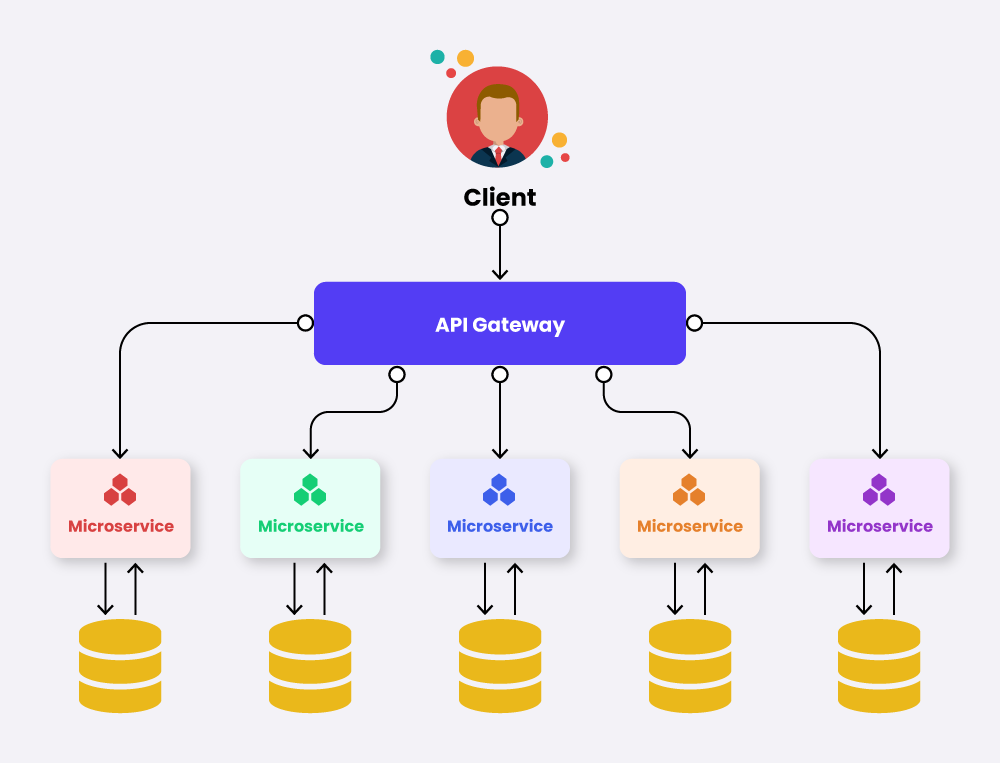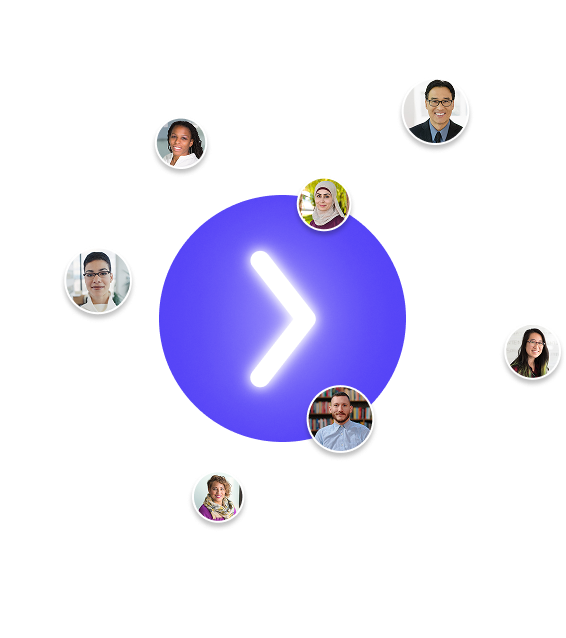
Subscribe to our Blog
We're committed to your privacy. SayOne uses the information you provide to us to contact you about our relevant content, products, and services. check out our privacy policy.

Akhil SundarJanuary 7, 202213 min read

Generating table of contents...
Businesses and enterprises of today look for microservices when they want to set up projects involving a reasonable amount of complexity and when these have to work efficiently. Microservices seem to be the answer.
Companies like Netflix, Amazon, Uber, and PayPal are enterprises that have shifted to microservices and have become market leaders in innovation. As we have observed, microservices have the power to turn companies around in terms of technology delivery and increased and leveraged business output.

A microservices system essentially comprises of several independent services that are loosely coupled, and all of them communicate via APIs. The individual services are developed, deployed, and maintained by individual small teams.
Microservices help businesses and enterprises deliver projects quickly. Some of the other advantages include reliability and easy maintenance.
Given the rising popularity of microservices, it is easy to figure out that microservices developers are in high demand now and that this demand is likely to stay in the coming years.
Software developer job opportunities are high in countries like the United States. High competition for tech talent has resulted in considerably high staffing times for candidates. Considering the fact that you need to appoint a large team for microservices, it is a good idea to opt for outsourcing instead of wasting time onboarding a large-sized team. The outsourcing team will do whatever is required to set up a talented microservices team.
Read our blog "How Microservices Architecture Consulting Services can Help".
Some of the benefits that companies can enjoy by outsourcing their software development services are listed below:
For software development outsourcing to work best, you should first make sure it matches your business needs and fits into the project’s schedule. It is also important to study the internal skills and resources that are available currently.
Setting aside a realistic and clear budget is important. Your organization would have to keep a lot of resources handy to shift into microservices. Outsourcing software engineers for setting up microservices would help you achieve product-market fit in the least amount of time and with unmatched results.
The microservices architecture that is used to structure applications is a modified version of the Service Oriented Architecture (SOA). Microservices make the individual applications independently deployable, highly testable, and maintainable because they are organized as a collection of loosely coupled services. This is the best structure for large applications that have to be quickly deployed regardless of their complexities.
The microservices language is named "microservice architecture pattern language," and this enables their smooth operation. This language is generally used to check the compatibility of any application with microservices.
The processes or services that communicate through a network in order to make a better application can be transformed into microservices. Microservices can be implemented using various tools and systems, including software, databases, hardware, etc.
Read our blog : Database Design in a Microservices Architecture
Microservices can be used to enhance the performance of a single component or multiple components. Though the microservices for components can be used simultaneously, the microservices for a specific component are run individually.
It is important for organizations to understand that the effort required to allow microservices is enormous. Microservices that can be independently deployed require many challenges to be overcome on the UI front. Each of the microservices has to be independently tested. All of them should also be tested together to ensure smooth operation. Even if a single service fails, reconfiguration becomes inevitable.
The characteristics of microservices systems include separate functional components that can be independently employed, services split according to business capabilities, decentralized open-source solutions for problems for use by any service, implementation of the microservices as a product model, and simple communication pathways having smart endpoints.
Choose a destination that has a large tech talent pool and organizations that have sufficient experience in outsourcing. As an example, India has a vast talent pool and top providers have their own development centers in many nations. The same is the case with eastern European countries like Romania, Ukraine, and Poland and some Southeast Asian nations. Among the Latin American countries, you can hire professionals from Mexico, Brazil, and Argentina.
However, a large talent pool is not the only factor. Critical understanding of the specific business domain is also an important part of microservices development.
You can engage microservices models using different engagement models: freelance, full-time, or contract.
The salaries paid to microservices developers vary by the location where they are from. In India, the average salary for a microservices developer is in the range of 12K USD per annum. If you hire someone from South Africa, their salary is in the range of 29K USD per annum. Hiring a microservices developer from the US would cost you anywhere between 75K USD and 103K USD per annum.
Read our blog : Why eCommerce Microservices & Headless Are the Future
Some companies engage microservices developers on an hourly basis. On average, in the United States, a microservices developer is paid close to 46 USD per hour. The salaries and wages paid to microservices developers are lower in developing nations when compared to developed nations like the UK and the USA.
Developer rates per hour in India are around 20 USD, 25 USD in China and other eastern countries, and 36 USD to 38 USD in eastern European countries.
Cultural Compatibility
After choosing the vendor, the teams can learn more about each other’s cultures so that they can adapt faster.
If you are planning to migrate to microservices and you are planning to outsource your microservices development, there are some criteria that are important when choosing a vendor. Successful migration happens only when the vendor has the requisite prior experience in the development of your kind of business applications. The company should have a versatile tech portfolio that includes DevOps, data, and cloud projects.
Ensure that the vendor you outsource to has completed projects using Java, JS/TypeScript, .NET, and Python. These are widely used in large-sized microservices projects. When it comes to deployment, AWS is a favourite. Therefore, it is important that your vendor has sufficient experience in managing AWS cloud services.
Download our eBook, "Choose the best microservices vendor and trim the costs."
Serverless technologies are becoming more popular these days. This is a situation when you can rely more on cloud service providers’ offerings than on your code and configurations. This means you can hire fewer personnel and work at reduced costs.
We believe in long-term win-win relationships with our strategic partners. If you want to migrate to microservices, call us today!The vendor should have expertise in dealing with data stores. Whereas monoliths have a single large centralized data store, microservices have an independent data store for each service. Experience with Kubernetes and ETL tools for data processing should help.
Hiring a microservices developer: What should you look for
Like any other software developer, it is essential for microservices developers to be good at both technical and soft skills. Thus recruiters can use skill assessment software like Ducknowl to test their technical and soft skills during the hiring process. It is also important that they have prior experience in the field of microservices development.
It is also essential that candidates exhibit strong problem-solving skills, have the ability to collaborate, carry forward and manage teamwork competencies, and possess a curiosity and desire for learning.
Read our blog : Automation Testing Strategies for Microservices
How to work with a microservices team from a software outsourcing company
The development model that you need for a specific project will depend on its size, the level of complexity, the timescale that you have in mind, and your budget. The most popular methodologies are Waterfall, DevOps, Scrum, Feature-Driven Development, and Kanban.
A detailed brief helps the developers to better understand your project and allows them to plan and appropriately prepare a workflow model.
Use of project management tools ensures that the microservices projects are executed efficiently. All the stakeholders involved would benefit from documented workflows and messaging threads.
Do not forget to test your product from beginning to end when you choose to work with software outsourcing companies. Both the parties involved have to be responsible for QA testing to mitigate the risk of any kind of error.
Understanding the migration from monoliths to microservices in detail is essential for building the teams that will help you in the exercise.
During the first stage of decomposition, the existing infrastructure is separated into modules or parts and checked for code duplication. This makes for a stable code which is compact and is easier to support. The second stage is decoupling, when you sever existing connections and turn the modules into separate and independently functioning microservices. This makes it easy to manage the different parts of the application. In place of a large application, developers are better off with a service that has a very narrow function to accomplish in the whole business process.
When hiring a microservices team, ensure that it is composed of the following personnel:
This person is responsible for designing the microservices application and executing the decomposition and decoupling processes. In addition to understanding the specific needs of the business domain, they should be able to match specific microservices to the different processes in the company.
Read our blog : 13 Best Practices to Secure Microservices Architecture
The software architect is responsible for selecting suitable technologies for event store, service discovery, service registry, containers for various services, and implementation. They also choose appropriate integration techniques, including API gateways for the service registry, orchestration, throttling, etc.
A product team for a Microservice
This team consists of a product owner, product managers, and business analysts who turn the business requirements into technical specifications. They communicate these business needs to the development teams and also manage budgets according to current requirements.
For successful implementation, there should be only one development team for the end-to-end development of one microservice. At worst, this team can work on two microservices. The team size should be between 5 and 9 people, and they should work autonomously and independently. The smaller the service, the better the outcome in terms of testability, maintainability, and ability to be deployed easily. For organizations following agile methodologies, team composition would also have a Scrum master, QA engineers, and developers.
For a small-sized project, one DevOps expert is enough. However, for a mid-sized one, you may need two such experts. They will be capable of handling CI/CD and managing environment costs.
Read our blog : How to find the Best Microservices Development Company
In addition to all of these, you may also require the services offered by a database administrator.
Do you want to deploy, manage, and scale up your mobile/on-premise/cloud microservices applications? Call us today!
Conclusion
For organizations moving into microservices, they should be worried on two counts: the first is about how to find the best microservices developers; the second one is about how to structure the team composition for the development of the microservices systems.
How Can SayOne Help
At SayOne, our integrated teams of developers service our clients with microservices that are fully aligned to the future of the business or organization. The microservices we design and implement are formulated around the propositions of Agile and DevOps methodologies. Our system model focuses on individual components that are resilient, fortified, and highly reliable.
We design microservices for our clients in a manner that assures future success in terms of scalability and adaptation to the latest technologies. They are also constructed to accept fresh components easily and smoothly, allowing for effective function upgrades in a cost-effective manner.
Our microservices are constructed with reusable components that offer increased flexibility and offer superior productivity for the organization or business. We work with start-ups, SMBs, and enterprises and help them to visualise the entire microservices journey and also allow for the effective coexistence of legacy systems in the organization.
Our microservices are developed for agility, efficient performance and maintenance, enhanced performance, scalability, and security.

We're committed to your privacy. SayOne uses the information you provide to us to contact you about our relevant content, products, and services. check out our privacy policy.

About Author
Subject Matter Expert

We collaborate with visionary leaders on projects that focus on quality